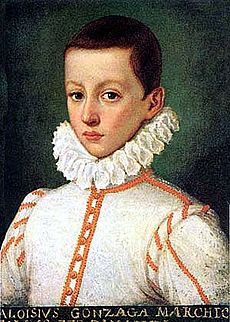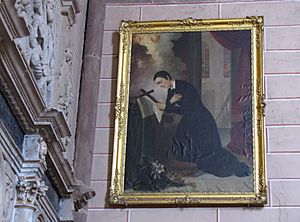Aloysius Gonzaga facts for kids
Quick facts for kids SaintAloysius de Gonzaga SJ |
|
|---|---|
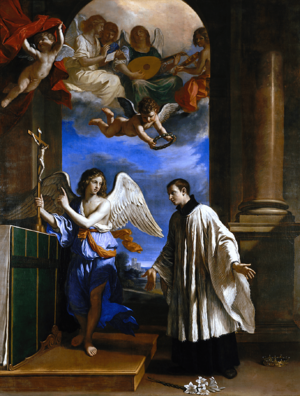
Aloysius Gonzaga (right) depicted in a painting by Guercino, c. 1650
|
|
| Confessor | |
| Born | 9 March 1568 Castiglione delle Stiviere, Duchy of Mantua, Holy Roman Empire |
| Died | 21 June 1591 (aged 23) Rome, Papal States |
| Venerated in | Catholic Church |
| Beatified | 19 October 1605, Rome, Papal States by Pope Paul V |
| Canonized | 31 December 1726, Rome, Papal States by Pope Benedict XIII |
| Major shrine | Church of Sant'Ignazio, Rome, Italy |
| Feast | 21 June |
| Attributes | Lily, Crown (headgear), cross, skull, rosary |
| Patronage | Young students, Christian youth, Jesuit scholastics, the blind, AIDS patients, AIDS care-givers; New Canaan, Connecticut |
Aloysius de Gonzaga (Italian: Luigi Gonzaga; 9 March 1568 – 21 June 1591) was an Italian nobleman. He became a member of the Society of Jesus, also known as the Jesuits. While he was a student, he sadly died while helping people sick during a serious epidemic. He was later recognized as a saint. The Catholic Church declared him "blessed" (beatified) in 1605 and a saint (canonized) in 1726.
Contents
Early Life and Calling
Aloysius was born on March 9, 1568, in a castle in Castiglione delle Stiviere, Italy. He was the oldest of eight children in the famous House of Gonzaga. His father, Ferrante de Gonzaga, was a Marquis, a type of nobleman.
His father expected Aloysius to become a soldier, as was common for noble sons. From age four, Aloysius learned about military life. He even marched with soldiers at age five!
Aloysius grew up in a time when life in Italy could be very challenging. When he was eight, he and his younger brother, Rodolfo, went to Florence for more education. While there, Aloysius became ill with a kidney problem that bothered him for the rest of his life. During his illness, he spent a lot of time reading about saints and praying.
In 1579, the brothers moved to Mantua. Aloysius was surprised by the wild and carefree lifestyle he saw there. He returned home to Castiglione and met Cardinal Saint Charles Borromeo. From him, Aloysius received his First Communion in 1580.
After reading about Jesuit missionaries in India, Aloysius felt a strong desire to become a missionary. He started teaching catechism (religious lessons) to young boys in the summers. He also began to live a very simple and disciplined life, focusing on prayer and spiritual growth.
In 1581, his family traveled to Spain. In Madrid, Aloysius decided he wanted to join a religious order. He chose the Jesuits, even though his father was very angry about it. Joining the Jesuits meant he would give up his right to inherit his father's title and wealth.
In 1584, the family returned to Italy. Aloysius still wanted to become a priest. His family tried to convince him to become a different kind of priest, one who could still have a high position in society. But Aloysius was determined to join the Jesuits and become a missionary.
Religious Life and Service
In November 1585, Aloysius gave up all his rights to his family's inheritance. He went to Rome and was accepted into the Society of Jesus. Because of his noble background, he even met Pope Sixtus V. During his training, he was encouraged to be less strict with himself and more social with the other new Jesuits.
Aloysius continued to have health problems, including kidney disease, skin issues, headaches, and trouble sleeping. He was sent to Milan for studies but had to return to Rome due to his health. On November 25, 1587, he took his three religious vows: chastity, poverty and obedience. These are promises to live a pure, simple, and obedient life. He then began studying theology to prepare for becoming a priest.

In 1591, a terrible plague (a widespread disease) broke out in Rome. The Jesuits opened a hospital to help the sick. Aloysius bravely volunteered to work there. He collected money for the victims and carried dying people from the streets to the hospital. He washed and fed the sick, helping them prepare for their final moments.
Aloysius found this work very difficult because of the terrible sights and smells. He had to work hard to overcome his physical dislike. Many young Jesuits became sick, so Aloysius's leaders told him not to go back to the hospital. But Aloysius asked again and was allowed to help at a different hospital, where contagious diseases were not admitted.
While helping a man there, Aloysius didn't know the man had the plague. Aloysius became sick himself and was bedridden by March 3, 1591, just before his 23rd birthday.
Aloysius got a little better for a while, but then his fever and cough returned. He grew weaker over many weeks. He spoke often with his spiritual guide, Robert Bellarmine, who later became a saint. Aloysius had a vision and told people he would die on June 21, 1591. On that day, he seemed well in the morning but insisted he would die before midnight. As he weakened, Bellarmine gave him the last rites (special prayers for the dying). Aloysius died just before midnight, holding a crucifix and trying to say the name of Jesus.
Aloysius was known for his great purity and love for God.
Becoming a Saint
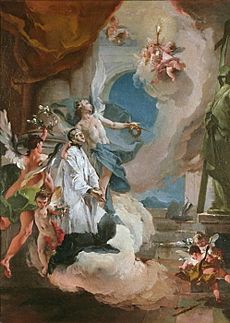
Aloysius was buried in a church in Rome that later became the Church of Saint Ignatius of Loyola. Many people believed he was a saint soon after he died. His remains were moved to a special urn in the Sant'Ignazio church. His head was later moved to a church in his hometown of Castiglione delle Stiviere.
He was declared "blessed" (beatified) by Pope Paul V in 1605, just 14 years after his death. On December 31, 1726, he was officially declared a saint (canonized) by Pope Benedict XIII, along with another Jesuit, Stanislaus Kostka.
Patronage
In 1729, Pope Benedict XIII named Aloysius de Gonzaga the patron saint of young students. In 1926, Pope Pius XI named him the patron of all Christian youth.
Because he died while caring for plague victims, he is also considered a patron saint of people with contagious diseases, including AIDS patients and those who care for them. He is also a patron saint of the town of Valmontone in Italy and Alezio, another small town in southern Italy.
How He is Shown in Art
In paintings and statues, Aloysius de Gonzaga is often shown as a young man. He wears a black cassock (a long robe) and a surplice (a white garment worn over the cassock). Sometimes he is shown as a page (a young servant in a noble household).
He is often shown with certain objects that represent his life:
- A lily, which stands for his innocence and purity.
- A cross, which shows his strong faith and willingness to make sacrifices.
- A skull, which reminds us of his early death.
- A rosary, which shows his devotion to the Blessed Virgin Mary.
Legacy and Celebrations
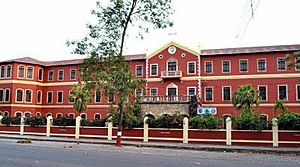
Saint Aloysius's feast day is celebrated every year on June 21, the day he died.
Many schools and churches around the world are named after Saint Aloysius.
- In Spokane, Washington, Gonzaga University and Gonzaga Preparatory School are named after him. There's also St. Aloysius Gonzaga Catholic School.
- The Oxford Oratory Church of St Aloysius Gonzaga is a Catholic church in Oxford, England.
- In Washington, D.C., Gonzaga College High School is a Catholic school for boys.
- St. Louis School, Hong Kong is a school for boys in Hong Kong.
- Mount Aloysius College is a Catholic college in Pennsylvania.
- Gonzaga College in Dublin, Ireland, and St Aloysius' College in Sydney, Australia, are Jesuit schools for boys.
- St Aloysius' College in Scotland is also a Catholic school.
- Many St. Aloysius Senior Secondary Schools are found throughout India.
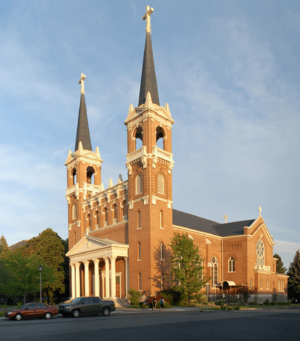
In Gelsenkirchen, Germany, a church has a stained-glass window of Saint Aloysius holding a soccer ball. This refers to the local soccer team, FC Schalke 04.
After Aloysius died, his brother Rodolfo's three daughters started a group of women dedicated to education. This group, called the Noble Virgins of Jesus, still exists today.
See Also
 In Spanish: Luis Gonzaga para niños
In Spanish: Luis Gonzaga para niños
- Aloysius
- Catholic Church in Italy
- List of Catholic saints
- St Aloysius (disambiguation)
- Saint Aloysius Gonzaga, patron saint archive
Images for kids
-
Aloysius Gonzaga (right) depicted in a painting by Guercino, c. 1650


